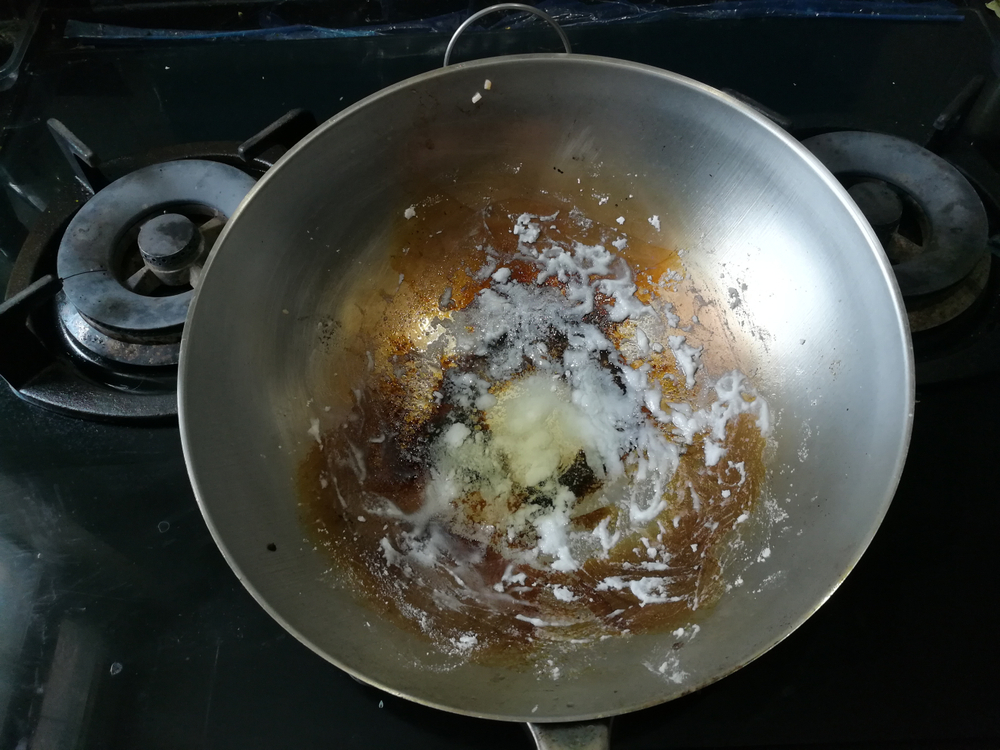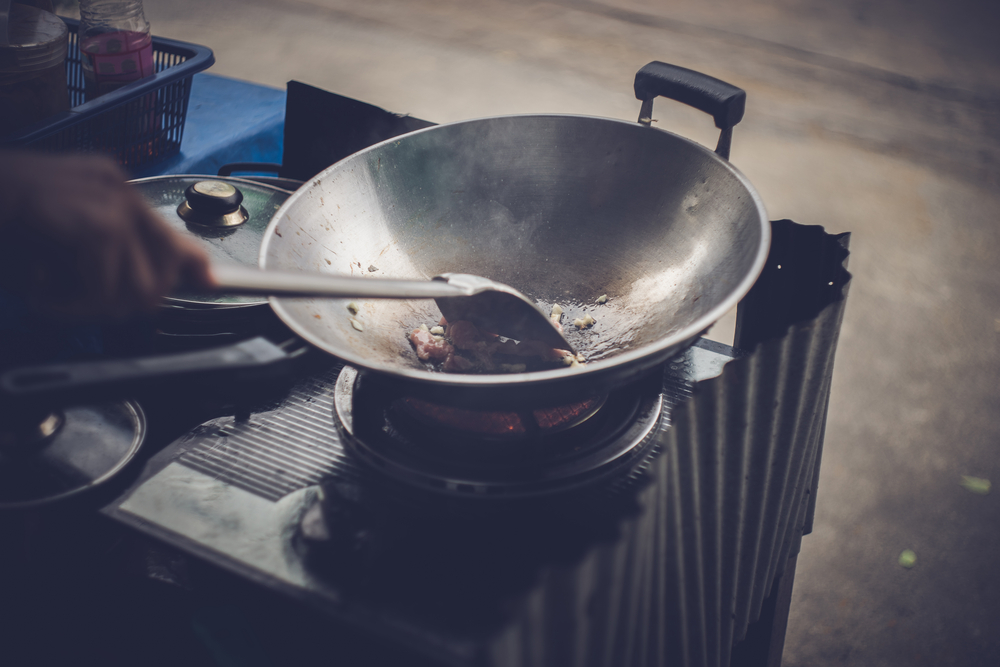Vegan Globetrotter is supported by our audience. When you purchase through one of our links, we may earn a small affiliate commission. As an Amazon Associate I earn from qualifying purchases. Your cost is not affected.
==================
Hey there, fellow home chefs and food enthusiasts, including our vegan friends! Let’s have a chat about wok cooking, shall we? It’s an exciting culinary adventure until your food decides to cling to the pan, whether you’re using an old or new wok, carbon steel, or stainless steel. But fret not, we’ve got your back when it comes to making that wok non-stick like a pro!
So, here’s the scoop. We’re about to unveil the magic of seasoning a wok. But before we get into the nitty-gritty, let’s talk about what seasoning is and why it’s crucial. Seasoning is like pampering your wok with some tender love and oil, creating a natural non-stick shield that not only keeps food from sticking but also elevates the flavors of your dishes. Pretty awesome, right? Now, let’s dive into the ‘how’ of seasoning your wok.

Seasoning Process for All Cookware, Not Only Your Wok
Seasoning is not restricted to woks alone. It’s a common practice used in treating a variety of cookware, especially those made of cast iron and carbon steel. However, today’s discussion focuses on ‘how to season a wok in the oven.’ But why should we season a wok in the first place? Let’s find out.
Why Season a Wok?
Seasoning a wok is a must for a bunch of excellent reasons!
First off, it’s like a magic trick for your wok – it turns it into a non-stick superstar. Cooking becomes a breeze, and cleanup? Piece of cake! But wait, there’s more! When your wok is well-seasoned, it gives your dishes that incredible ‘wok hei’ flavor. You know, that rich, smoky goodness that’s like a secret ingredient you can’t get with any other pan.
Oh, and rust? Say goodbye to that worry! Most woks are made of carbon steel or cast iron, and those materials are rust-prone without some seasoning love.
And last but not least, it’s all about paying tribute to tradition. The wok is a real OG in the Chinese culinary world, used for centuries. Seasoning it? That’s like giving a nod to the culinary ancestors – pretty cool, right?

Types of Woks that Require Seasoning
Let’s get into the nitty-gritty – which woks need some seasoning love? Well, it all comes down to what they’re made of. Here’s the lowdown:
First up, we’ve got carbon steel woks. These are like the MVPs – lightweight, heat things up evenly, and they’re champs at stir-frying, deep-frying, and searing. No wonder chefs and home cooks swear by them.
Then there’s cast iron woks. They’re the strong, silent type – a bit heavier and slower to heat up, but they hold onto that high heat for a long time. Great for those marathon cooking sessions.
Lastly, stainless steel woks. They’re a bit less common because they’re not as non-stick as the others, but with a little seasoning magic, they can still get the job done pretty darn well.
The Process: How to Season a Wok in the Oven
Let’s break down the steps for seasoning your wok in the oven – no rocket science here!
Step one, it’s all about giving that wok a good wash. Cleanliness is critical to bid farewell to any manufacturing oils that might mess with your seasoning game. So, get it sparkling clean.
Step two: don’t forget to give it a thorough drying session. You don’t want rust creeping in, so make sure it’s bone-dry. Now, onto the juicy stuff – the seasoning itself. Grab an oil with a high smoke point, like grapeseed, canola, or peanut oil. Think of it as your wok’s favorite spa treatment. Slather on a thin layer of that oil, inside and out.
And the grand finale? Pop that wok upside down into a hot oven, set at around 450°F (232°C). It’s like sending it to the sauna to soak in all that goodness.
How to Season Stainless Steel Wok
Now, let’s delve into how to season a stainless steel wok. The process is similar to seasoning a carbon steel or cast iron wok, but there are a few differences. Stainless steel woks have a slick, non-porous surface, so they require a bit more patience and attention during the seasoning process.
Like with other woks, you’ll need to start by thoroughly cleaning and drying your stainless steel wok. Then, apply a thin layer of high smoke point oil all over the wok. Add oil to the wok in a preheated oven set at 350°F (176°C) and leave it for about an hour. Once the wok is cooled, it’s ready to be used.

Seasoning Carbon Steel Wok: Step-by-Step Guide
Seasoning a carbon steel wok follows a similar process.
- Clean the Wok: Carbon steel woks usually come with a layer of factory oil to prevent rust during storage and shipping. You’ll need to scrub this off with warm soapy water and a non-abrasive sponge. Rinse and dry thoroughly.
- Apply Oil: Using a paper towel, apply a thin layer of high smoke point oil to the entire surface of the wok, inside and out.
- Heat in Oven: Place the wok upside down in a preheated oven set at 450°F (232°C) and leave it for 20 minutes.
- Cool and Repeat: After 20 minutes, carefully remove the wok (it will be very hot) and let it cool. Repeat the oiling and heating process 3-4 times until the wok develops a dark, non-stick patina.
How Long Does it Take to Season a Wok
One common question is, “How long does it take to season a wok?” The answer depends on several factors, including the type of wok, the seasoning method used, and the type of oil used. However, generally speaking, the oven method of seasoning a wok takes anywhere from 1 to 2 hours.
Do You Have to Season a Wok?
A straight answer to the question, “Do you have to season a wok?” is a resounding yes! Seasoning a wok is not just about creating a non-stick surface; it’s also about enhancing the flavor of your food, preventing rust, and preserving the lifespan of your wok.
Here are the factual reasons why seasoning a wok is essential:
- Creating a Non-Stick Surface: One of the primary objectives of seasoning a wok is to establish a non-stick surface. This process involves heating the wok and applying a thin layer of oil, which, when correctly done, fills the microscopic pores in the metal. This prevents food from sticking and allows for even heat distribution, ensuring that your stir-fries and other dishes cook evenly.
- Enhancing Flavor: Seasoning imparts a unique, smoky flavor to your dishes, often called “wok hei” or “breath of the wok.” This flavor is a result of the high-heat cooking and the seasoned surface of the wok, which adds a distinctive, savory note to your meals that is difficult to achieve with other cooking methods or cookware.
- Preventing Rust: Woks are typically made from carbon steel, which is susceptible to rust when exposed to moisture. By seasoning the wok, you create a protective layer that acts as a barrier between the metal and air, effectively preventing rust from forming. This is especially important as woks are frequently used in high-heat, high-moisture cooking.
- Preserving Longevity: Properly seasoning and caring for your wok can significantly extend its lifespan. Regular seasoning and maintenance ensure that the wok remains in good condition, free from rust and corrosion. A well-seasoned wok can last for generations, making it a worthwhile investment for any cooking enthusiast.
Best Oil to Use for Wok Seasoning
The best oil to use for wok seasoning is one with a high smoke point. Examples include grapeseed oil, canola oil, peanut, vegetable oil,, and flaxseed oil. Avoid using oils with low smoke points, like olive oil or butter, as they can burn and create a sticky surface instead of a non-stick one.

Factual Considerations and Personal Variations in Wok Seasoning
Wok seasoning and re-seasoning are essential practices to maintain the performance and longevity of your wok. While there are standard procedures that are generally followed, it’s crucial to recognize that wok seasoning can involve some individual variations based on the specific wok type, its condition, and personal preferences. Here are some factual considerations and areas where personal variations may occur:
1. Assessment of Wok Condition
- Factual: Assessing the condition of your wok is an essential step before deciding on the re-seasoning approach.
- Personal Variation: The extent of wok damage or wear can vary, and the decision to perform targeted re-seasoning or a full re-seasoning depends on the individual wok’s condition.
2. Cleaning the Wok
- Factual: Thoroughly cleaning the wok before re-seasoning is universally recommended to remove any old food residues or oil that may hinder the seasoning process.
- Personal Variation: The choice of cleaning products and methods can vary, but it’s essential to ensure the wok is entirely free of contaminants.
3. Targeted Re-Seasoning
- Factual: Applying oil to specific areas and heating to create a new seasoning layer is a method often used to address minor issues, such as localized loss of seasoning.
- Personal Variation: The number of repetitions and the choice of oil can vary based on personal preferences and desired results.
4. Full Re-Seasoning
- Factual: Completely re-seasoning the wok in the oven is a common method to refresh its seasoning. The suggested temperature and number of repetitions are typical guidelines.
- Personal Variation: Some cooks may adjust the temperature or the number of repetitions based on the wok’s material and their experience.
5. Testing the Re-Seasoned Wok
- Factual: Testing the wok after re-seasoning is essential to ensure it performs well and imparts the desired “wok hei” flavor to dishes.
- Personal Variation: The choice of test dishes and the evaluation of the wok’s performance can vary based on individual preferences and cooking styles.
Wok seasoning is a practice grounded in factual principles that enhance the non-stick properties of the wok, preserve its longevity, and infuse a unique flavor into dishes. While there are standard procedures, personal variations are common and should be embraced. Individual experiences and preferences play a role in the seasoning process, allowing each cook to tailor the method to their specific wok and culinary style. As you embark on your wok seasoning journey, feel free to experiment and find the best approach for you and your beloved wok.
Truly Mastering the Art of Wok Seasoning
Frequently Asked Questions
Can I Use My Wok Right Away, or Do I Need to Season It First?
Is It Normal for the Wok to Change Color During Seasoning?
Can I Use Any Oil for Seasoning, or Are There Specific Oils I Should Use?
🌱 Dive into the World of Vegan Cooking with VeganGlobetrotter!
- Facebook: Join Us
- Instagram: Follow Us
- Pinterest: Pin It
- Twitter: Tweet with Us


Don't miss out
when new recipes and information are added!
Join our newsletter for free recipes,
healthy living inspiration, and special offers
You have Successfully Subscribed!